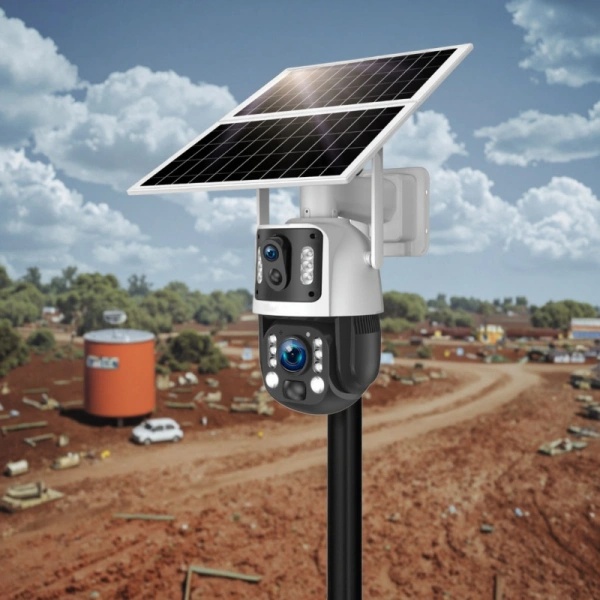Analysis of Key Drivers and Development Opportunities in the Solar-Powered Security Camera Industry
1. Key Industry Drivers
1.1 Widespread Demand in Off-Grid and Remote Areas
-
Large-scale demand from farms, orchards, fish ponds, forests, construction sites, mines, and remote rural regions where electricity and internet infrastructure is lacking.
-
Traditional wired surveillance systems are difficult to deploy; solar + 4G/WiFi systems are the ideal alternative.
1.2 Global Clean Energy Initiatives
-
Governments worldwide are promoting renewable energy, accelerating the adoption of solar-powered devices.
-
Carbon neutrality goals and ESG compliance encourage the use of eco-friendly security solutions.
1.3 Rising Security Awareness
-
Growing concerns over theft, vandalism, wild animal intrusions, and workplace safety drive the need for real-time remote monitoring.
-
Post-pandemic demand has shifted toward contactless and unmanned monitoring solutions.
1.4 Rapid Technological Advancements
-
Continuous improvement in battery life, solar panel efficiency, 4G modules, and low-power chipsets.
-
Modern cameras offer features like HD video, night vision, PIR motion detection, AI human detection, 2-way audio, cloud & local storage.
1.5 Plug-and-Play Simplicity
-
No wiring, no professional installation required — perfect for DIY users.
-
Ideal for direct-to-consumer (D2C) channels like Amazon, Walmart, and global e-commerce platforms.
2. Market Opportunities
2.1 Massive Potential in Rural and Developing Regions
-
Over 3 billion people live in rural or off-grid areas globally, with very low security coverage.
-
Emerging markets like Southeast Asia, South Asia, Africa, Latin America, and the Middle East are growing rapidly.
2.2 B2B Projects and System Integrations
-
Governments, telecom operators, security integrators, construction companies, and infrastructure projects need solar-powered surveillance.
-
Local distributor partnerships and OEM/ODM cooperation are key to expansion.
2.3 Branding and Differentiation Trends
-
The market is shifting from price competition to value-driven competition.
-
Brands offering high-quality, stable products with strong support will gain market trust and long-term success.
2.4 Product Diversification & System Integration
-
Evolving from standalone cameras to integrated solar monitoring systems (camera + solar panel + battery + cloud/app).
-
Seamless integration with IoT, smart agriculture, smart cities, and AI platforms adds value and functionality.
2.5 Cross-Industry Applications
-
Applications extend beyond security — including agriculture, forestry patrols, environmental monitoring, and border control.
-
Combines well with AI edge computing, low-power wireless tech (NB-IoT, LoRa), and remote management systems.
3. Challenges and Strategic Advice
| Challenge | Suggested Solution |
|---|---|
| Market flooded with low-quality products | Focus on premium quality, establish brand reputation |
| High regulatory and certification barriers | Prepare for CE, FCC, RoHS, ISO, and market-specific compliance early |
| Logistics and after-sales limitations overseas | Set up regional warehouses and localized support services |
| Rising technical complexity | Invest in R&D for core technologies (e.g., ultra-low power AI, long standby battery systems) |
| Challenge | Strategic Suggestion |
|---|---|
| 🔄 Global 4G Band Compatibility Most brands only support regional bands (e.g., B1/B3/B8 for Asia), limiting overseas expansion. |
Invest in global 4G module integration, supporting 99% of bands across USA, EU, JP, AU, Africa, LATAM markets. Develop auto-switching and regional customization capabilities. |
| 🕒 True 24/7 Continuous Recording Limitations Many “AOV” (Always-On Video) functions on the market are motion-triggered or limited by storage/battery constraints — not true 24/7. |
Develop ultra-low-power architecture with smart BMS + continuous-loop recording logic, supporting 24/7 operation with large-capacity SD card/cloud backup. Integrate AI to auto-prioritize key clips. |
| 🔋 Weak or Unsafe BMS Power Management Poor battery management system (BMS) design can lead to overcharging, overheating, or even explosion risks — a major safety concern. |
Adopt industrial-grade BMS chips and algorithms with multi-layer protection: overcharge, discharge, temp, current. Ensure certified battery safety (MSDS, UN38.3). Use LiFePO4 batteries for higher safety margin. |
| 🔭 Lack of Optical Zoom Lens Options Most competitors only provide fixed lens or digital zoom; very few support optical zoom due to high cost and technical complexity. |
Invest in motorized optical zoom modules (e.g., 5X–10X), enabling clear identification of faces, plates, distant objects. Match with high-speed PTZ and AI auto-tracking for premium applications. |
| 📦 Proliferation of Low-Quality Products Price war has flooded the market with unstable, short-lifespan devices. |
Focus on high-reliability design, strict QC, and long-term brand building. Avoid short-term price-driven strategy. |
| 🌍 Global Certification and Compliance Barriers Many regions require CE/FCC/RoHS or even local telecom certifications. |
Prepare for certification early. Establish standard-compliant product SKUs for key markets. Provide documentation and test reports for B2B clients. |
| 🛠️ Lack of After-Sales Support & Logistics Overseas customers face long delivery times, poor warranty response, and language barriers. |
Set up regional warehouses, provide localized support (multi-language manuals, apps, FAQs), and offer flexible warranty policies. |
| 🧠 Technical Complexity of Future Trends As features grow (AI, IoT, cloud, edge computing), many OEMs cannot keep up. |
Build a strong R&D team, focus on modular product architecture for fast iteration. Cooperate with chip/platform providers for long-term tech support. |
4. Conclusion
The solar-powered security camera market is transitioning from a niche category to a mainstream security solution. Driven by clean energy trends and the need for flexible surveillance, it presents an unprecedented window of opportunity in the next 3–5 years.
Brands and manufacturers who can deliver high-performance, reliable, and easy-to-use solutions — along with effective global distribution and branding — will emerge as market leaders.

